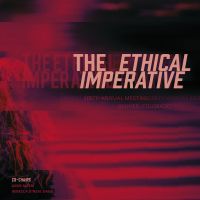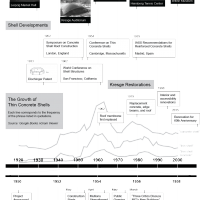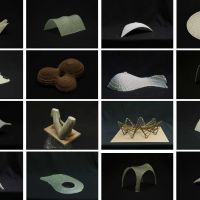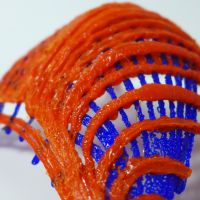Tag: shell-structures
-
 Mohamed Ismail Presents at ACSA 20182018-03-17, Tags: conceptual-design conceptual-structural-design constructabililty design-tool shell-structures structural-optimization visualization
Mohamed Ismail Presents at ACSA 20182018-03-17, Tags: conceptual-design conceptual-structural-design constructabililty design-tool shell-structures structural-optimization visualizationMohamed presented his paper entitled "Resistance Through Form: Synthesis Structures in the Design of a Residential Architecture for Khartoum, Sudan" at the Association of Collegiate Schools of Architecture's (ACSA) 106th Annual Meeting in Denver, Colorado, on March 17th, 2018. He presented his paper in the session "Architecture of the other 99%? – Power, Economy, and the Dilemma of History", and then joined a panel discussion moderated by Professor Ole Fischer of the University of Utah.
-
 Thin concrete shells at MIT: Kresge Auditorium and the 1954 conferenceWilliam Plunkett and Caitlin Mueller, Proceedings of the 5th International Congress on Construction History, 2015
Thin concrete shells at MIT: Kresge Auditorium and the 1954 conferenceWilliam Plunkett and Caitlin Mueller, Proceedings of the 5th International Congress on Construction History, 2015This paper presents original research on two historical developments in the field of thin-shell concrete structures in the United States, both at the Massachusetts Institute of Technology (MIT) in Cambridge, Massachusetts in the 1950s. The first topic is the design and construction of MIT’s Kresge Auditorium (1953-1955), enclosed by a concrete shell on three supports designed by architect Eero Saarinen (1910-1961). The second topic is a seminal conference on the architecture, engineering, and construction of thin concrete shells hosted by MIT in 1954, which included presentations by architect-engineer Felix Candela (1910-1997), engineer Anton Tedesko (1903-1994), architect Philip Johnson (1906-2005), among many important designers and scholars.
Both the building and the conference are historically significant, and together, they mark the peak of a design era optimistic about the enduring value of thin-shell concrete structures. However, they also reflect the underlying tensions and contradictions of thin-shell concrete technology that contributed to its limited use in subsequent decades. The project therefore serves as an early example illustrating the limitations of thin-shell concrete applied to arbitrary formal ideas.
The concurrent conference often related directly to the design and construction of Kresge Auditorium: both its structural engineer (Charles Whitney, Ammann and Whitney) and contractor (Douglas Bates, George A. Fuller Company) presented papers, and a proceedings summary notes that “this conference has…cantilevered out from Saarinen’s dome.” The conference highlights broad enthusiasm for thin-shell concrete structures, but also reveals disagreements between theoreticians and practitioners, architects and engineers, and designers and builders. This paper gives a critical review of the influential conference, based on conference proceedings and supporting historical documents.
In summary, this paper contributes new knowledge on the history and significance of paired events in thin-shell concrete in the 1950s at MIT. In addition to detailed accounts of both the building and conference, the paper offers original insight about their contextual role in the rise and fall of thin-shell concrete technology in the design and construction community.
-
 4.154: Un-flat Options StudioClass, 2015
4.154: Un-flat Options StudioClass, 2015Taught with Joel Lamere in Spring 2015, this options-level architectural design studio is part of the cross-studio initiative, a new program to develop studios that connect design with other disciplines. Called Un-flat Inevitabilities: Integrated Form and Structure in the Age of Simulation and Composites, the studio focuses on possibilities and frictions at the interface of architectural geometry and structural performance, as facilitated by contemporary computational tools and processes that integrate structural thinking and design intent. The extended studio brief is as follows:
Architecture’s enduring preoccupation with structure as a formal alibi has evolved alongside the tools we use to define and evaluate geometries. The fidelity between structurally-informed shape and architectural object is continually constrained to representable forms, calculable structural behaviors and other short-hand abstractions that simulate how objects will act and react once materialized. The history of architectural structures revels in this abstraction; Gaudi’s hanging-chain models reduce structure to the funicular, Nervi’s flow lines literalize graphic notation, Candela’s hypars exploit a coincidence between pure geometries and known equations.
We are only now beginning to graduate from a long period of computational infancy in architecture. New modeling tools, static and parametric, free architectural geometry from the representational limitations of the past. Computer-aided and digital fabrication processes are increasingly commonplace and potentially liberating. Simultaneously, the material palette available to architecture is expanding, with composites leading the way toward an eroding set of formal constraints. But most importantly to us, computational tools are emerging that promise to embed sophisticated structural behaviors into the design process. Through these, the necessary abstractions of previous generations can be replaced by simulative environments that allow a convergence of formal ambition and structural logics. This convergence allows us to imagine and construct an expanded set of possible forms, each deeply reflecting real-world material behaviors.
Yet the contingencies of architecture, the other criteria around which it must operate, resist the purity of this exercise. Take, for instance, the perfect beam, one for which efficiency is the only criteria: curved along the top and bottom with an ever-changing cross section reflecting various performative changes along its length. But as soon as you need to occupy the top of this beam one side becomes flat, and as soon as you need to make it the cross section stabilizes; a beam is inherently inefficient. This slippage -- between structural efficiency and other architectural demands -- is the most fertile ground for this new computational moment. Integrated processes and new simulative environments can embrace this call for flatness, while tapping into the un-flat inevitabilities of structural form.
The studio included a one-week trip to Mexico City to study the thin-shell concrete structures of architect-engineer Felix Candela, which inspired and contextualized many of the studio's themes.
-
 Stress line additive manufacturing (SLAM)Research, 2014 - 2015
Stress line additive manufacturing (SLAM)Research, 2014 - 2015The project presents a new integrated software and hardware process that reconsiders the traditional addive manufacturing (AM) technique of fused deposition modelling (FDM) by adding material explicitly along the three-dimensional principal stress trajectories, or stress lines, of 2.5-D structural surfaces. Using a six-axis robotic arm, this project materializes continuous stress fields into discrete structural topologies, rendered computationally as robotic tool paths. The goal of this project is to develop and perfect this new technique, and to explore conditions in which it is favorable to conventional layer-based additive manufacturing. The research is supported by methodologies including computational structural analysis and comparative structural load testing. For more video information, see this YouTube video.
-
 Stress line generation for structurally performative architectural designKam-Ming Mark Tam and Caitlin Mueller, Computational Ecologies: Proceedings of the 35th Annual Conference of the Association for Computer Aided Design in Architecture, 2015
Stress line generation for structurally performative architectural designKam-Ming Mark Tam and Caitlin Mueller, Computational Ecologies: Proceedings of the 35th Annual Conference of the Association for Computer Aided Design in Architecture, 2015Principal stress lines, which are pairs of orthogonal curves that indicate trajectories of internal forces and therefore idealized paths of material continuity, naturally encode the optimal topology for any structure for a given set of boundary conditions. Although stress line analysis has the potential to offer a direct, and geometrically provocative approach to optimization that can synthesize both design and structural objectives, its application in design has generally been limited due to the lack of standardization and parameterization of the process for generating and interpreting stress lines. Addressing these barriers that limit the application of the stress line methods, this paper proposes a new implementation framework that will enable designers to take advantage of stress line analysis to inform conceptual structural design. Central to the premise of this research is a new conception of structurally inspired design exploration that does not impose a singular solution, but instead allows for the exploration of a diverse high-performancedesign space in order to balance the combination of structural and architectural design objectives.


